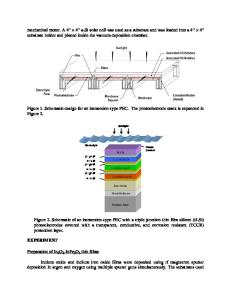Electrochromic switching of tungsten oxide films grown by reactive ion-beam sputter deposition
- PDF / 1,319,078 Bytes
- 14 Pages / 595.276 x 790.866 pts Page_size
- 55 Downloads / 329 Views
Electrochromic switching of tungsten oxide films grown by reactive ion-beam sputter deposition Mario Gies1,3,* , Fabian Michel1,3, Christian Lupo´2,3, Derck Schlettwein2,3, Martin Becker1,3, and Angelika Polity1,3 1
Institute for Exp. Physics I, Justus-Liebig-University Giessen, 35392 Giessen, Germany Institute of Applied Physics, Justus-Liebig-University Giessen, 35392 Giessen, Germany 3 Center for Materials Research (LaMa), Justus-Liebig-University Giessen, 35392 Giessen, Germany 2
Received: 26 June 2020
ABSTRACT
Accepted: 8 September 2020
Chromogenic thin films are crucial building blocks in smart windows to modulate the flux of visible light and heat radiation into buildings. Electrochromic materials such as tungsten oxide are well established in those devices. Sputter deposition offers a well-suited method for the production of such layers, which can also be used on an industrial scale. Tungsten oxide films were prepared by means of reactive ion-beam sputter deposition. The choice of distinct gas mixtures as well as the growth temperature during the sputtering process allows to tune the properties of the resulting layers. Especially, the variation in the growth temperatures was found to have an impact on the structure of the resulting samples and, as a consequence, on their optical and electrochemical properties. By specific choice of the reactive gas, the deposition of colorless transparent as well as blue films of different composition is possible. The optical transmittance in the visible spectral range was up to 75% for as-deposited oxygen-rich layers. Additionally, hydrogen-doped tungsten oxide samples were grown. Superior electrochromic switching was observed for Hþ -doped layers, probably by some kind of preconditioning. This resulted in a value for the standardized optical coloration efficiency of 26.5 cm2 /C.
Published online: 6 October 2020
Ó
The Author(s) 2020
Introduction Because of the global climate change, energy-saving and sustainable technologies are becoming more and more important. Therefore, the demands on
technologies for the conversion, storage and use of renewable energies are constantly growing [1]. The building sector plays an important role in terms of energy saving potential. For example, this sector consumes 23% of global primary energy and 30% of global electricity demand [2]. The further
Handling Editor: Kevin Jones.
Address correspondence to E-mail: [email protected]
https://doi.org/10.1007/s10853-020-05321-y
616
J Mater Sci (2021) 56:615–628
development of technologies that enable energy to be used efficiently and economically is, therefore, of foremost interest. In particular, the class of so-called smart windows offers an approach to save energy in the building sector by efficiently regulating incident light [3]. This can be achieved by the use of electrochromic (EC) thin films. Electrochromism denotes the reversible change of optical absorbance driven by an externally applied voltage; thus, EC materials allow for the modulation of the inciden
Data Loading...










